Page 26 of 475
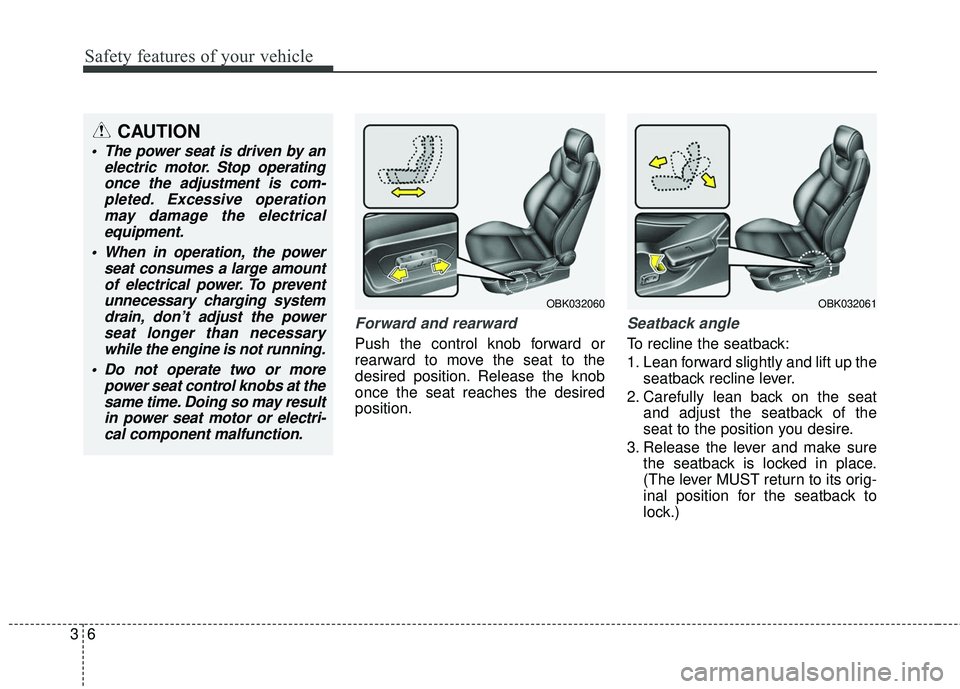
Safety features of your vehicle
63
Forward and rearward
Push the control knob forward or
rearward to move the seat to the
desired position. Release the knob
once the seat reaches the desired
position.
Seatback angle
To recline the seatback:
1. Lean forward slightly and lift up theseatback recline lever.
2. Carefully lean back on the seat and adjust the seatback of the
seat to the position you desire.
3. Release the lever and make sure the seatback is locked in place.
(The lever MUST return to its orig-
inal position for the seatback to
lock.)
CAUTION
The power seat is driven by anelectric motor. Stop operatingonce the adjustment is com-pleted. Excessive operationmay damage the electricalequipment.
When in operation, the power seat consumes a large amountof electrical power. To preventunnecessary charging systemdrain, don’t adjust the powerseat longer than necessarywhile the engine is not running.
Do not operate two or more power seat control knobs at thesame time. Doing so may resultin power seat motor or electri-cal component malfunction.
OBK032060OBK032061
Page 29 of 475
39
Safety features of your vehicle
Removal/Reinstall
To remove the headrest:
1. Recline the seatback (2) with therecline lever or switch (1).
2. Raise headrest as far as it can go.
3. Press the headrest release button (3) while pulling the headrest up
(4). To reinstall the headrest :
1. Put the headrest poles (2) into the
holes while pressing the release
button (1).
2. Recline the seatback (4) with the recline lever or switch (3).
3. Adjust the headrest to the appro- priate height. Active headrest (if equipped)
The active headrest is designed to
move forward and upward during a
rear impact. This helps prevent the
driver's and front passenger’s heads
from moving backward and thus
helps minimize neck injuries.
OBK033069OBK033070HNF2041-1
WARNING
NEVER allow anyone to ride in a
seat with the headrest removed.
WARNING
Always make sure the headrest
locks into position after rein-
stalling and adjusting it properly.
Page 32 of 475
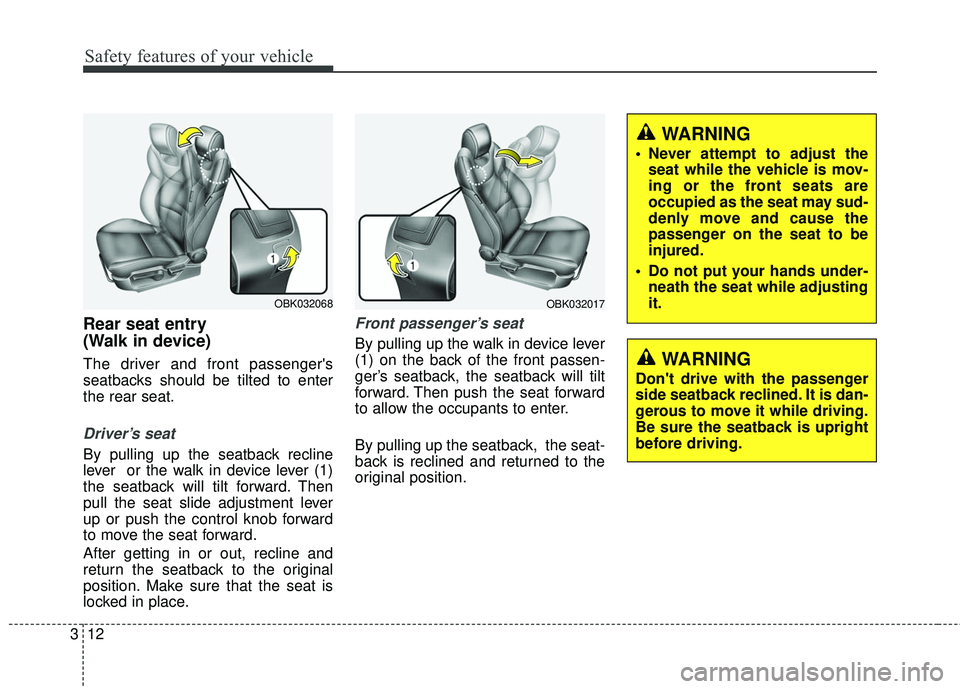
Safety features of your vehicle
12
3
Rear seat entry
(Walk in device)
The driver and front passenger's
seatbacks should be tilted to enter
the rear seat.
Driver’s seat
By pulling up the seatback recline
lever or the walk in device lever (1)
the seatback will tilt forward. Then
pull the seat slide adjustment lever
up or push the control knob forward
to move the seat forward.
After getting in or out, recline and
return the seatback to the original
position. Make sure that the seat is
locked in place.
Front passenger’s seat
By pulling up the walk in device lever
(1) on the back of the front passen-
ger’s seatback, the seatback will tilt
forward. Then push the seat forward
to allow the occupants to enter.
By pulling up the seatback, the seat-
back is reclined and returned to the
original position.
OBK032017
WARNING
Don't drive with the passenger
side seatback reclined. It is dan-
gerous to move it while driving.
Be sure the seatback is upright
before driving.
WARNING
Never attempt to adjust the
seat while the vehicle is mov-
ing or the front seats are
occupied as the seat may sud-
denly move and cause the
passenger on the seat to be
injured.
Do not put your hands under- neath the seat while adjusting
it.
OBK032068
Page 33 of 475
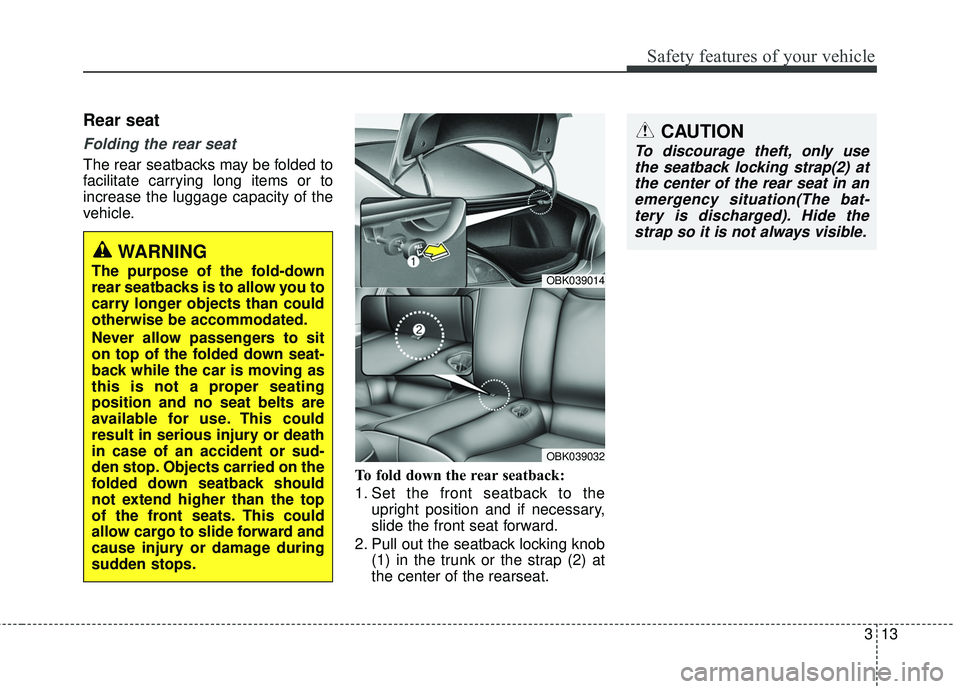
313
Safety features of your vehicle
Rear seat
Folding the rear seat
The rear seatbacks may be folded to
facilitate carrying long items or to
increase the luggage capacity of the
vehicle.To fold down the rear seatback:
1. Set the front seatback to theupright position and if necessary,
slide the front seat forward.
2. Pull out the seatback locking knob (1) in the trunk or the strap (2) at
the center of the rearseat.
WARNING
The purpose of the fold-down
rear seatbacks is to allow you to
carry longer objects than could
otherwise be accommodated.
Never allow passengers to sit
on top of the folded down seat-
back while the car is moving as
this is not a proper seating
position and no seat belts are
available for use. This could
result in serious injury or death
in case of an accident or sud-
den stop. Objects carried on the
folded down seatback should
not extend higher than the top
of the front seats. This could
allow cargo to slide forward and
cause injury or damage during
sudden stops.OBK039014
OBK039032
CAUTION
To discourage theft, only usethe seatback locking strap(2) atthe center of the rear seat in anemergency situation(The bat-tery is discharged). Hide thestrap so it is not always visible.
Page 34 of 475
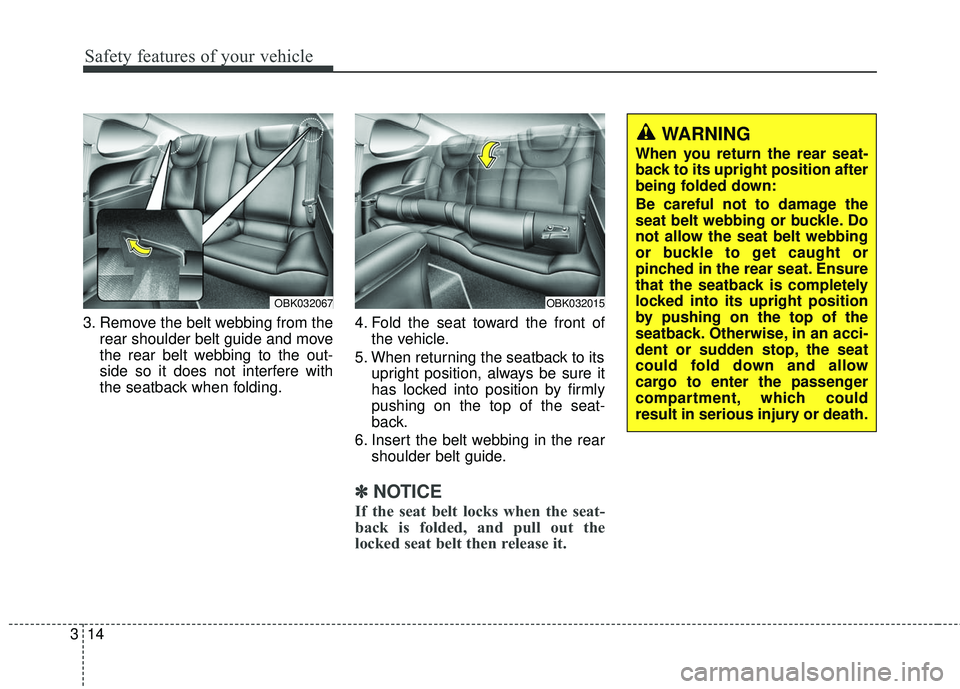
Safety features of your vehicle
14
3
3. Remove the belt webbing from the
rear shoulder belt guide and move
the rear belt webbing to the out-
side so it does not interfere with
the seatback when folding. 4. Fold the seat toward the front of
the vehicle.
5. When returning the seatback to its upright position, always be sure it
has locked into position by firmly
pushing on the top of the seat-
back.
6. Insert the belt webbing in the rear shoulder belt guide.
✽ ✽NOTICE
If the seat belt locks when the seat-
back is folded, and pull out the
locked seat belt then release it.
OBK032015OBK032067
WARNING
When you return the rear seat-
back to its upright position after
being folded down:
Be careful not to damage the
seat belt webbing or buckle. Do
not allow the seat belt webbing
or buckle to get caught or
pinched in the rear seat. Ensure
that the seatback is completely
locked into its upright position
by pushing on the top of the
seatback. Otherwise, in an acci-
dent or sudden stop, the seat
could fold down and allow
cargo to enter the passenger
compartment, which could
result in serious injury or death.
Page 38 of 475
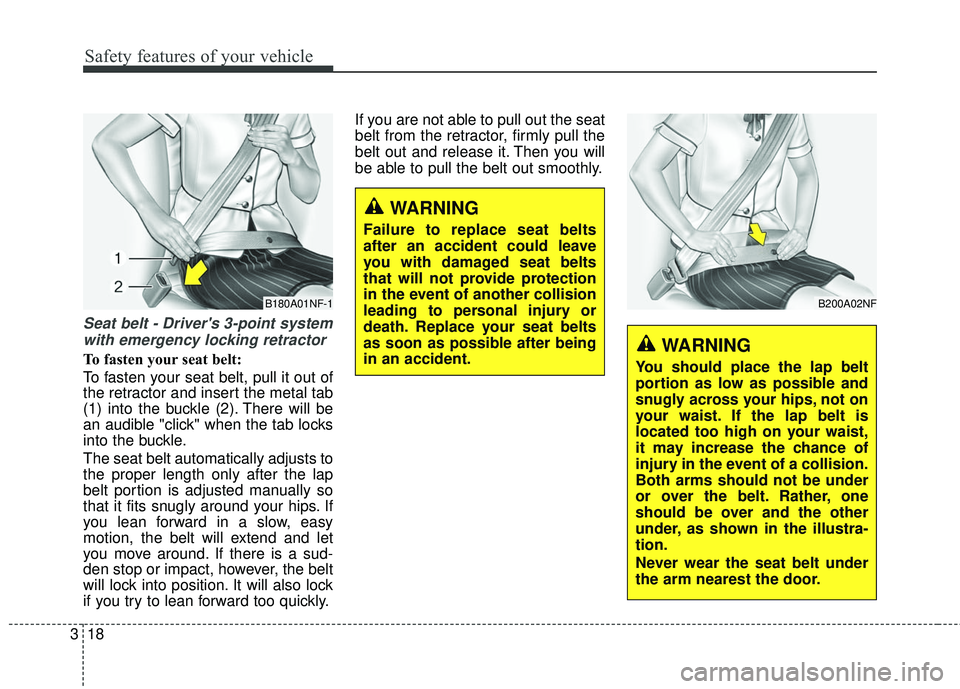
Safety features of your vehicle
18
3
Seat belt - Driver's 3-point system
with emergency locking retractor
To fasten your seat belt:
To fasten your seat belt, pull it out of
the retractor and insert the metal tab
(1) into the buckle (2). There will be
an audible "click" when the tab locks
into the buckle.
The seat belt automatically adjusts to
the proper length only after the lap
belt portion is adjusted manually so
that it fits snugly around your hips. If
you lean forward in a slow, easy
motion, the belt will extend and let
you move around. If there is a sud-
den stop or impact, however, the belt
will lock into position. It will also lock
if you try to lean forward too quickly. If you are not able to pull out the seat
belt from the retractor, firmly pull the
belt out and release it. Then you will
be able to pull the belt out smoothly.
WARNING
Failure to replace seat belts
after an accident could leave
you with damaged seat belts
that will not provide protection
in the event of another collision
leading to personal injury or
death. Replace your seat belts
as soon as possible after being
in an accident.
B200A02NF
WARNING
You should place the lap belt
portion as low as possible and
snugly across your hips, not on
your waist. If the lap belt is
located too high on your waist,
it may increase the chance of
injury in the event of a collision.
Both arms should not be under
or over the belt. Rather, one
should be over and the other
under, as shown in the illustra-
tion.
Never wear the seat belt under
the arm nearest the door.
B180A01NF-1
Page 39 of 475
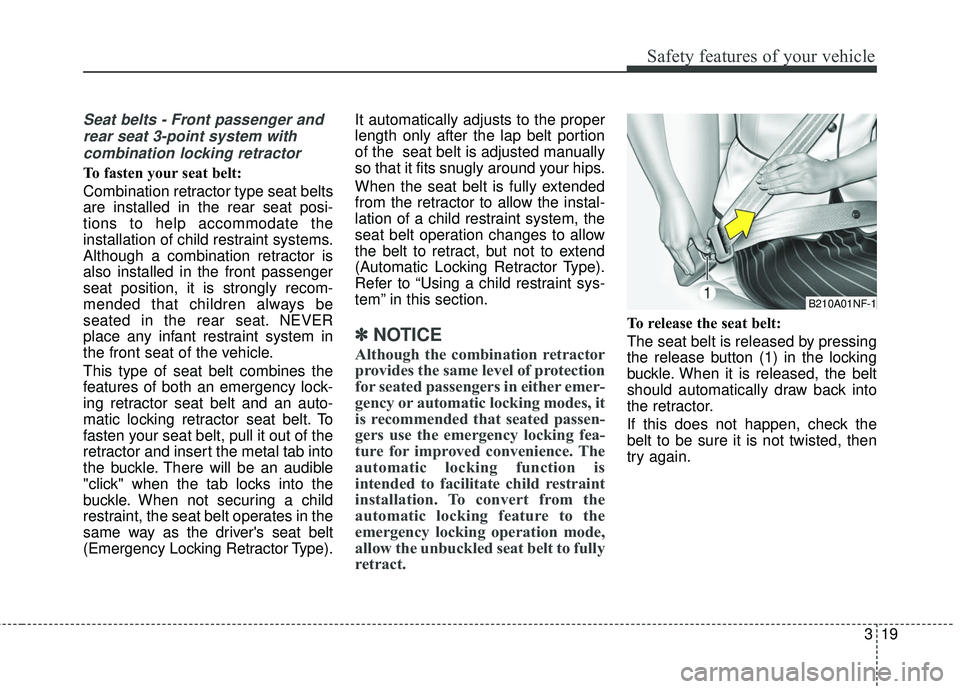
319
Safety features of your vehicle
Seat belts - Front passenger andrear seat 3-point system withcombination locking retractor
To fasten your seat belt:
Combination retractor type seat belts
are installed in the rear seat posi-
tions to help accommodate the
installation of child restraint systems.
Although a combination retractor is
also installed in the front passenger
seat position, it is strongly recom-
mended that children always be
seated in the rear seat. NEVER
place any infant restraint system in
the front seat of the vehicle.
This type of seat belt combines the
features of both an emergency lock-
ing retractor seat belt and an auto-
matic locking retractor seat belt. To
fasten your seat belt, pull it out of the
retractor and insert the metal tab into
the buckle. There will be an audible
"click" when the tab locks into the
buckle. When not securing a child
restraint, the seat belt operates in the
same way as the driver's seat belt
(Emergency Locking Retractor Type). It automatically adjusts to the proper
length only after the lap belt portion
of the seat belt is adjusted manually
so that it fits snugly around your hips.
When the seat belt is fully extended
from the retractor to allow the instal-
lation of a child restraint system, the
seat belt operation changes to allow
the belt to retract, but not to extend
(Automatic Locking Retractor Type).
Refer to “Using a child restraint sys-
tem” in this section.
✽ ✽
NOTICE
Although the combination retractor
provides the same level of protection
for seated passengers in either emer-
gency or automatic locking modes, it
is recommended that seated passen-
gers use the emergency locking fea-
ture for improved convenience. The
automatic locking function is
intended to facilitate child restraint
installation. To convert from the
automatic locking feature to the
emergency locking operation mode,
allow the unbuckled seat belt to fully
retract.
To release the seat belt:
The seat belt is released by pressing
the release button (1) in the locking
buckle. When it is released, the belt
should automatically draw back into
the retractor.
If this does not happen, check the
belt to be sure it is not twisted, then
try again.
B210A01NF-1
Page 40 of 475
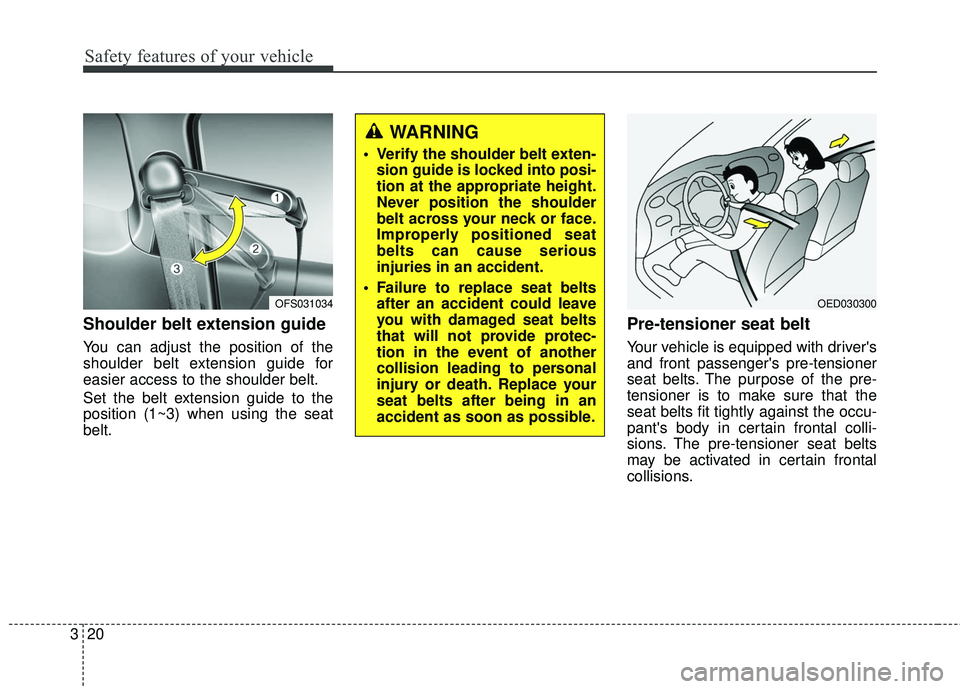
Safety features of your vehicle
20
3
Shoulder belt extension guide
You can adjust the position of the
shoulder belt extension guide for
easier access to the shoulder belt.
Set the belt extension guide to the
position (1~3) when using the seat
belt.
Pre-tensioner seat belt
Your vehicle is equipped with driver's
and front passenger's pre-tensioner
seat belts. The purpose of the pre-
tensioner is to make sure that the
seat belts fit tightly against the occu-
pant's body in certain frontal colli-
sions. The pre-tensioner seat belts
may be activated in certain frontal
collisions.
OFS031034OED030300
WARNING
Verify the shoulder belt exten-
sion guide is locked into posi-
tion at the appropriate height.
Never position the shoulder
belt across your neck or face.
Improperly positioned seat
belts can cause serious
injuries in an accident.
Failure to replace seat belts after an accident could leave
you with damaged seat belts
that will not provide protec-
tion in the event of another
collision leading to personal
injury or death. Replace your
seat belts after being in an
accident as soon as possible.